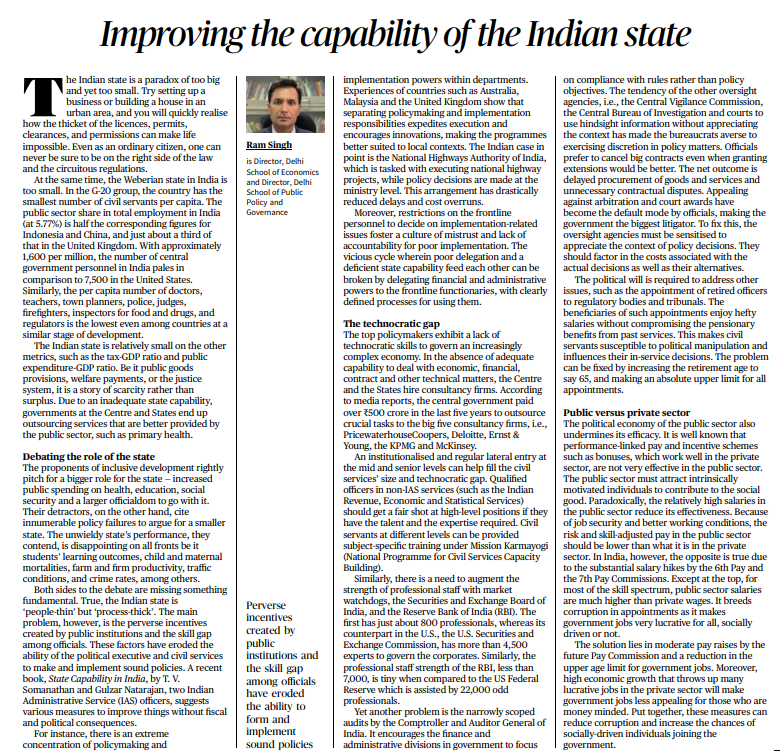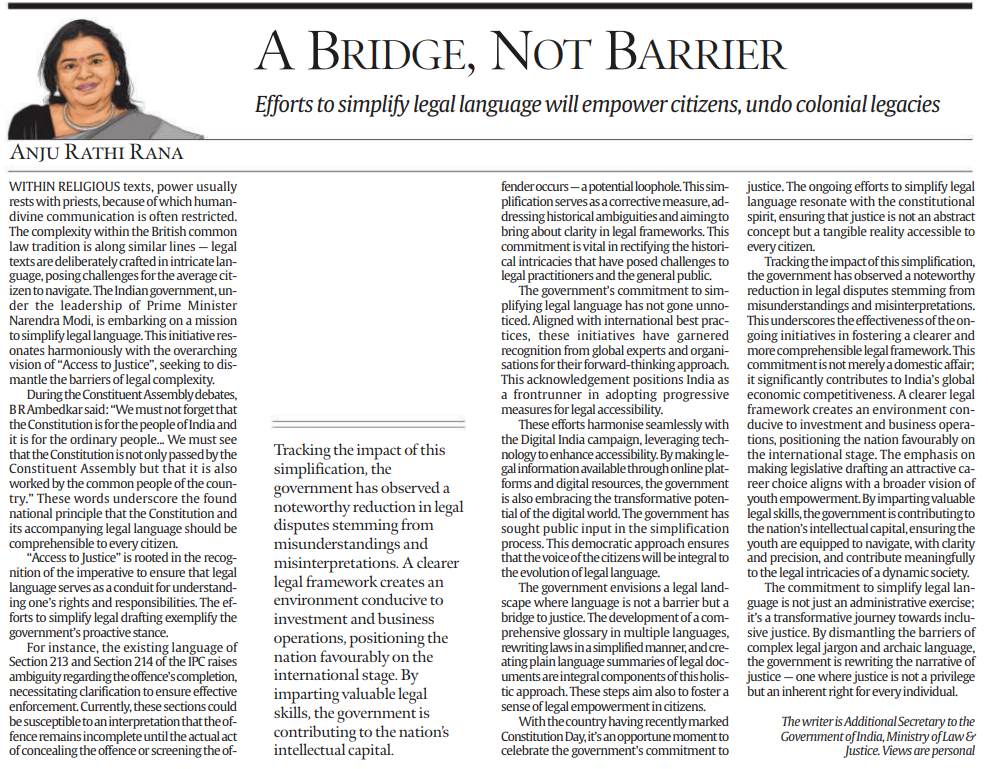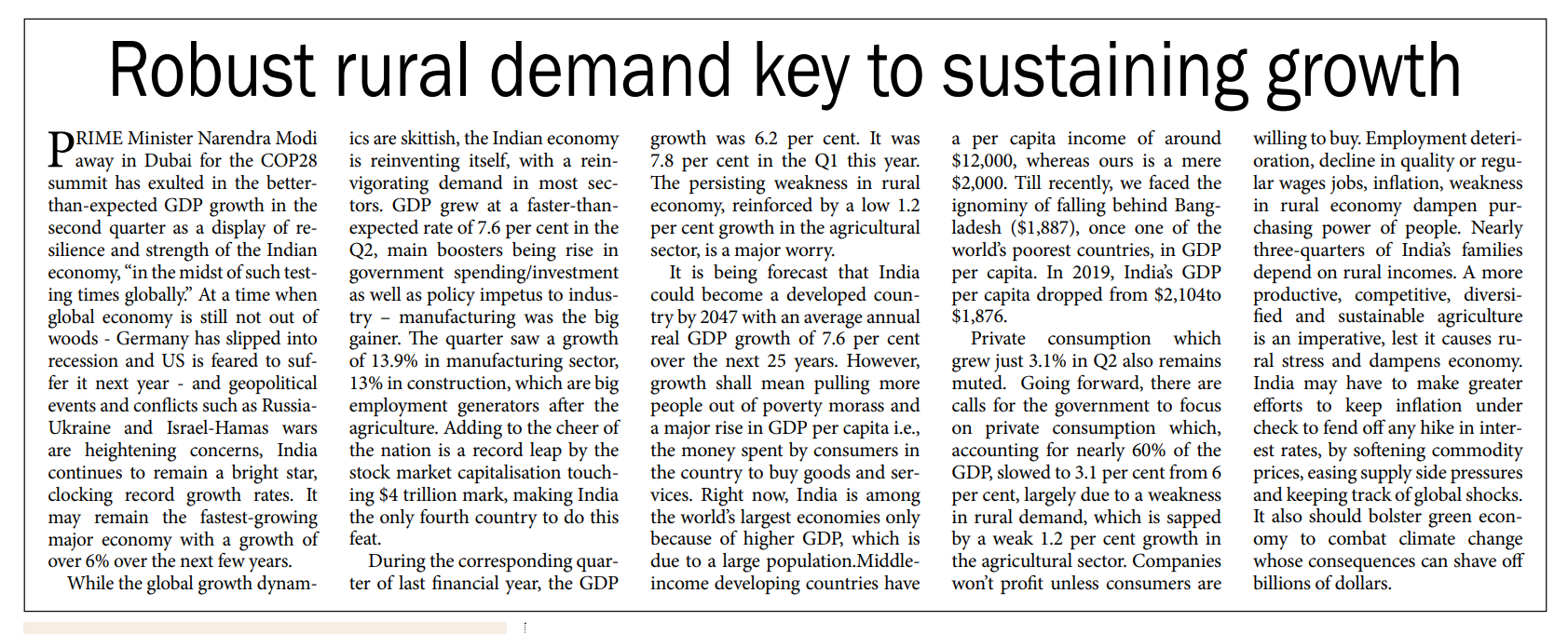"The Paradox of the Indian State"
Introduction:
The Indian state is described as a paradox, simultaneously too big and too small. The complexities of licenses, permits, clearances, and permissions make it challenging for individuals to engage in business or construction in urban areas. Despite its size, the Indian state is argued to be small in terms of civil servants per capita and public sector employment.
Size Discrepancy:
- The Indian state is highlighted as ‘people-thin’ but ‘process-thick,’ facing challenges in policy implementation and lacking capabilities in crucial sectors.
- The public sector’s share in employment, tax-GDP ratio, and public expenditure-GDP ratio is comparatively low, leading to scarcity in public goods provisions.
The Role of the State Debate:
- A debate between proponents and detractors revolves around the size of the state.
- Advocates for inclusive development call for increased state intervention in health, education, and social security, while opponents point to policy failures and advocate for a smaller state.
Perverse Incentives and Skill Gap:
- The key issue is identified as perverse incentives and a skill gap among officials, affecting the ability of the state to formulate and implement effective policies.
- The book “State Capability in India” proposes measures to address these challenges without fiscal and political consequences.
Policy Suggestions:
- Decentralization: Drawing from international experiences, separating policymaking and implementation responsibilities is recommended for quicker execution and innovation
- Delegation of Powers: Delegating financial and administrative powers to frontline functionaries is proposed to break the cycle of poor delegation and deficient state capability.
- Technocratic Gap: Addressing the lack of technocratic skills in top policymakers by instituting regular lateral entry at mid and senior levels is suggested.
Strengthening Oversight and Accountability:
- Audit Reforms: Broadening the scope of audits by oversight agencies like the Comptroller and Auditor General is recommended to focus on policy objectives rather than mere rule compliance.
- Contextual Sensitization: Oversight agencies should appreciate the context of policy decisions, factoring in costs and alternatives to avoid delayed procurement and contractual disputes.
Political Will and Institutional Reforms:
- Retirement Age: Increasing the retirement age and imposing an absolute upper limit for appointments to regulatory bodies can mitigate political manipulation.
- Performance-Linked Pay: Adjusting public sector salaries to reflect job security and working conditions, reducing corruption, and attracting socially-driven individuals is proposed.
Conclusion:
The editorial emphasizes the need for a balanced approach, addressing the paradoxical nature of the Indian state by implementing structural reforms, enhancing state capability, and promoting a more effective and accountable public sector.
Transformative Initiatives in Legal Language Simplification: A Path to Inclusive Justice
Introduction:
Within religious texts and legal traditions, power often lies in complex language, creating barriers for the common citizen.
Recognizing this, the Indian government, led by Prime Minister Narendra Modi, is actively working to simplify legal language, aligning with the vision of “Access to Justice.”
Foundational Principles:
- The Constitution’s architect, B R Ambedkar, emphasized that legal language must be accessible to all citizens.
- The government’s commitment to “Access to Justice” underscores the need for comprehensible legal language, ensuring that every citizen understands their rights and responsibilities.
Government’s Proactive Stance:
- Ongoing efforts to simplify legal drafting demonstrate the government’s proactive approach.
- Addressing historical ambiguities, like those in Section 213 and 214 of the IPC, reflects a commitment to clarity in legal frameworks, benefiting both practitioners and the public.
Global Recognition:
Internationally, India’s commitment to simplifying legal language is acknowledged as a progressive step, aligning with global best practices. This recognition positions India as a leader in adopting measures for legal accessibility.
Digital Integration:
- Harmonizing with the Digital India campaign, the government leverages technology to enhance accessibility.
- Online platforms and digital resources not only simplify language but also embrace the transformative potential of the digital world.
- Public input in the simplification process ensures a democratic and inclusive approach.
Holistic Approach to Legal Empowerment:
- The government envisions a legal landscape where language is a bridge, not a barrier, to justice.
- Creating glossaries, rewriting laws in a simplified manner, and providing plain language summaries empower citizens with knowledge, fostering a sense of legal empowerment.
Impact and Observations:
- The government’s simplification efforts have resulted in a reduction in legal disputes, indicating the effectiveness of ongoing initiatives.
- This commitment extends beyond domestic affairs, contributing to India’s global economic competitiveness by creating an investment-friendly environment.
Youth Empowerment and Legal Education:
- The emphasis on making legislative drafting an attractive career choice aligns with a broader vision of youth empowerment.
- By integrating plain language drafting principles into legal education, the government nurtures a generation of legal professionals equipped to navigate legal intricacies with clarity.
Conclusion:
The government’s commitment to simplify legal language goes beyond administration; it is a transformative journey towards inclusive justice.
By dismantling barriers of complex legal jargon, the government is rewriting the narrative of justice, ensuring that it is not a privilege but an inherent right for every individual.
This evolution positions India as a leader in fostering legal accessibility on a global scale.




